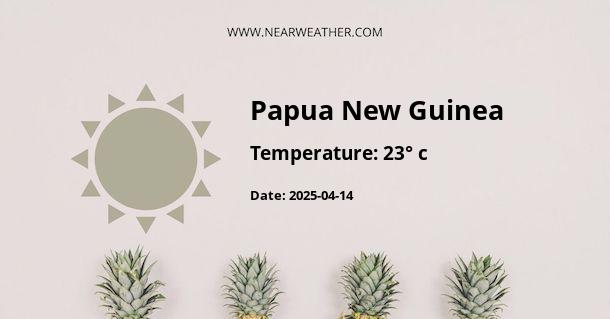Weather
23° 
Climate Conditions: overcast clouds
Humidity: 82%
Wind speed: 5.87 km/h
Wind direction: 6°
Daily Weather Forecast
Monday
04/14/2025
Climate Conditions: light rain
Humidity: 83%
Tuesday
04/15/2025
Climate Conditions: light rain
Humidity: 88%
Wednesday
04/16/2025
Climate Conditions: light rain
Humidity: 87%
Thursday
04/17/2025
Climate Conditions: light rain
Humidity: 91%
Friday
04/18/2025
Climate Conditions: light rain
Humidity: 90%
Evolution
Daily Weather Forecast Evolution (°C)
Lowest temperature
Highest temperature
Other Information
Sunrise
06:12
Sunset
18:11
Latitude
-6.000000
Longitude
147.000000
Timezone: GMT+05:30
More about Papua New Guinea:
Climate and Weather in Papua New Guinea
Papua New Guinea (PNG), officially known as the Independent State of Papua New Guinea, is a country located in the southwestern Pacific Ocean. It is known for its stunning natural beauty, diverse cultures, and rich biodiversity. The climate in Papua New Guinea is characterized by high temperatures, high humidity, and significant rainfall throughout the year. Let's explore the climate and weather patterns in this fascinating country.Geographical Factors
Papua New Guinea is situated just south of the equator, which means it experiences a tropical climate. The country's geography plays a significant role in shaping its weather patterns. It is surrounded by the Pacific Ocean, which contributes to the high humidity and abundant rainfall. The country is divided into four main regions: the Highlands, the Islands, the Momase region, and the Southern region. Each region has its own unique climate characteristics.Highlands Region
The Highlands region of Papua New Guinea is located in the central part of the country and is characterized by mountainous terrain. The climate in this region is cooler than in other parts of the country due to its higher elevation. The temperatures here range from 16°C (61°F) to 28°C (82°F) year-round. The Highlands experience a distinct wet and dry season, with the wet season occurring from December to March and the dry season from June to September. During the wet season, heavy rainfall can lead to landslides and flooding in some areas.Islands Region
The Islands region of Papua New Guinea consists of numerous islands, including New Britain, New Ireland, and Bougainville. The climate in this region is influenced by the surrounding ocean, resulting in high humidity and consistent temperatures throughout the year. The average temperatures range from 24°C (75°F) to 31°C (88°F). The Islands experience a wet season from November to April, with the heaviest rainfall occurring between December and March. The dry season, from May to October, brings milder temperatures and less rainfall.Momase Region
The Momase region is located in the northern part of Papua New Guinea and includes provinces such as Morobe, Madang, and Sepik. The climate in this region is hot and humid throughout the year. The average temperatures range from 26°C (79°F) to 32°C (90°F). The Momase region experiences a wet season from December to March, with heavy rainfall and occasional tropical cyclones. The dry season, from May to October, brings drier and milder weather.Southern Region
The Southern region of Papua New Guinea includes the capital city, Port Moresby, as well as the Gulf and Central provinces. The climate in this region is tropical, with high temperatures, high humidity, and relatively low rainfall. The average temperatures range from 24°C (75°F) to 32°C (90°F). The Southern region experiences a wet season from December to March, with occasional heavy rainfall and thunderstorms. The dry season, from May to October, is characterized by milder temperatures and less rainfall.Precipitation and Rainfall
Papua New Guinea receives a significant amount of rainfall throughout the year. The coastal regions and mountainous areas receive the highest rainfall totals, with some areas receiving up to 8,000 millimeters (315 inches) of rainfall annually. The wettest months are typically from December to March, coinciding with the wet season in most regions. The country's rainfall patterns are influenced by the monsoon winds and the Inter-Tropical Convergence Zone (ITCZ). The ITCZ is a belt of low pressure near the equator where trade winds from the northern and southern hemispheres meet, causing upward motion and the formation of clouds and rain.Tropical Cyclones
Papua New Guinea is prone to tropical cyclones, also known as typhoons or hurricanes, especially in the northern and coastal regions. The cyclone season in the country typically runs from November to April, with the highest risk occurring between January and March. These cyclones can bring strong winds, heavy rainfall, and storm surges, resulting in widespread damage and flooding.Conclusion
In conclusion, Papua New Guinea experiences a tropical climate with high temperatures, high humidity, and significant rainfall throughout the year. The country's diverse geography, including its mountainous terrain and coastal regions, contributes to variations in climate patterns across different regions. It is important for visitors and residents alike to be prepared for the country's wet and dry seasons, as well as the potential risks associated with tropical cyclones.FAQ's about Papua New Guinea's Weather:
Q - What is the Latitude and Longitude of Papua New Guinea?
A - Papua New Guinea's Latitude is -6.000000 & Longitude is 147.000000.
Q - What is the weather in Papua New Guinea today?
A - Weather in Papua New Guinea is 23° today.
Q - What is the climatic condition of Papua New Guinea today?
A - Climate Conditions in Papua New Guinea shows overcast clouds today.
Q - What is the humidity in Papua New Guinea today?
A - Humidity in Papua New Guinea is 82% today.
Q - What is the wind speed in Papua New Guinea today?
A - Wind speed in Papua New Guinea is 5.87 km/h, flowing at 6° wind direction. today.

Latest searched locations